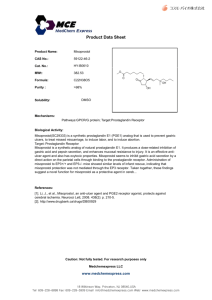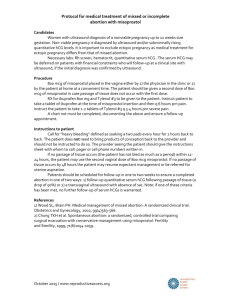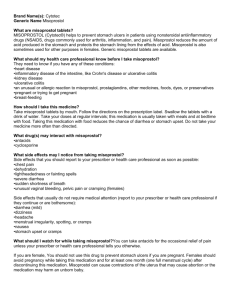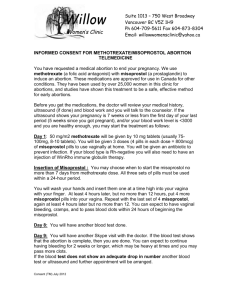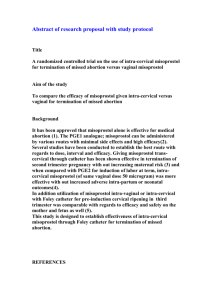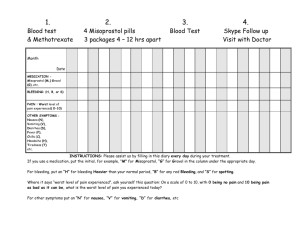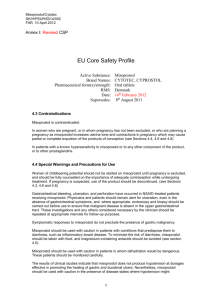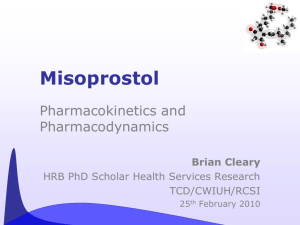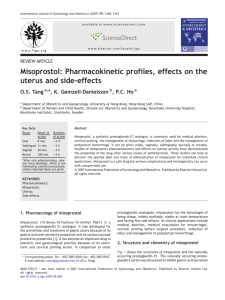Annex I : Final CSP, clean
advertisement
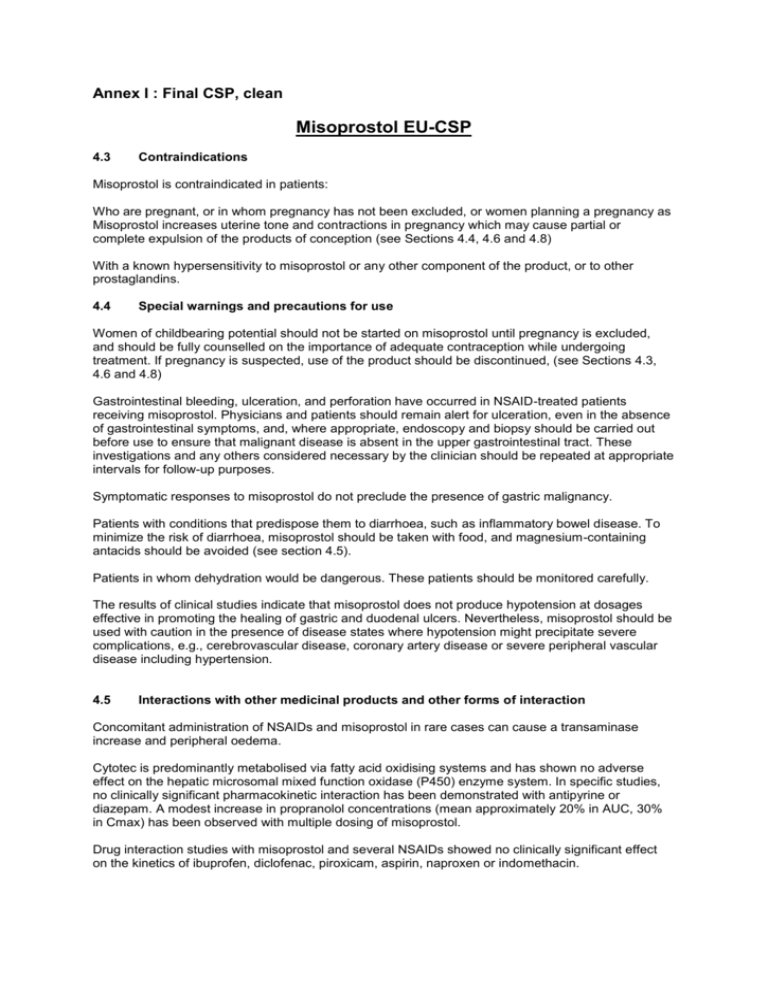
Annex I : Final CSP, clean Misoprostol EU-CSP 4.3 Contraindications Misoprostol is contraindicated in patients: Who are pregnant, or in whom pregnancy has not been excluded, or women planning a pregnancy as Misoprostol increases uterine tone and contractions in pregnancy which may cause partial or complete expulsion of the products of conception (see Sections 4.4, 4.6 and 4.8) With a known hypersensitivity to misoprostol or any other component of the product, or to other prostaglandins. 4.4 Special warnings and precautions for use Women of childbearing potential should not be started on misoprostol until pregnancy is excluded, and should be fully counselled on the importance of adequate contraception while undergoing treatment. If pregnancy is suspected, use of the product should be discontinued, (see Sections 4.3, 4.6 and 4.8) Gastrointestinal bleeding, ulceration, and perforation have occurred in NSAID-treated patients receiving misoprostol. Physicians and patients should remain alert for ulceration, even in the absence of gastrointestinal symptoms, and, where appropriate, endoscopy and biopsy should be carried out before use to ensure that malignant disease is absent in the upper gastrointestinal tract. These investigations and any others considered necessary by the clinician should be repeated at appropriate intervals for follow-up purposes. Symptomatic responses to misoprostol do not preclude the presence of gastric malignancy. Patients with conditions that predispose them to diarrhoea, such as inflammatory bowel disease. To minimize the risk of diarrhoea, misoprostol should be taken with food, and magnesium-containing antacids should be avoided (see section 4.5). Patients in whom dehydration would be dangerous. These patients should be monitored carefully. The results of clinical studies indicate that misoprostol does not produce hypotension at dosages effective in promoting the healing of gastric and duodenal ulcers. Nevertheless, misoprostol should be used with caution in the presence of disease states where hypotension might precipitate severe complications, e.g., cerebrovascular disease, coronary artery disease or severe peripheral vascular disease including hypertension. 4.5 Interactions with other medicinal products and other forms of interaction Concomitant administration of NSAIDs and misoprostol in rare cases can cause a transaminase increase and peripheral oedema. Cytotec is predominantly metabolised via fatty acid oxidising systems and has shown no adverse effect on the hepatic microsomal mixed function oxidase (P450) enzyme system. In specific studies, no clinically significant pharmacokinetic interaction has been demonstrated with antipyrine or diazepam. A modest increase in propranolol concentrations (mean approximately 20% in AUC, 30% in Cmax) has been observed with multiple dosing of misoprostol. Drug interaction studies with misoprostol and several NSAIDs showed no clinically significant effect on the kinetics of ibuprofen, diclofenac, piroxicam, aspirin, naproxen or indomethacin. Magnesium-containing antacids should be avoided during treatment with misoprostol as this may worsen the misoprostol-induced diarrhoea. 4.6 Pregnancy and lactation Pregnancy Misoprostol is contraindicated in women who are pregnant because it induces uterine contractions and is associated with abortion, premature birth, and foetal death and birth defects. First trimester exposure to misoprostol is associated with a significantly increased risk of two birth defects; Möbius sequence, i.e., palsies of cranial nerves VI and VII, and terminal transverse limb defects. Other defects including arthrogryposis have been observed. Lactation Misoprostol is rapidly metabolised in the mother to misoprostol acid, which is biologically active and is excreted in breast milk. Misoprostol should not be administered to nursing mothers because the excretion of misoprostol acid could cause undesirable effects such as diarrhoea in nursing infants. 4.7 Effects on ability to drive and use machines Cytotec can cause dizziness. Patients should be cautioned about operating machinery and driving. 4.8 Undesirable effects The Adverse reaction terms were then categorized utilizing the incidence rate as follows: Very Common: 1/10 (>10%) Common: 1/100 and 1/10, (>1% and <10%) Uncommon: 1/1000 and 1/100, (>0.1% and <1%) Rare: 1/10,000 and 1/1000, (>0.01% and <0.1%) Very Rare: 1/10,000, (<0.01%) Not Known Immune System Disorder Not Known Nervous System Disorders Common Gastrointestinal Disorders Very common Common Skin and Subcutaneous Tissue Disorders Very Common Pregnancy, puerperium, and perinatal conditions Not Known Reproductive System and Breast Disorders Uncommon Rare Not Known Congenital, Familial and Genetic Disorders Not Known General Disorders and Administration Site Anaphylactic reaction Dizziness, headache Diarrhoea* Abdominal pain*, constipation, dyspepsia, flatulence, nausea, vomiting Rash Amniotic fluid embolism, abnormal uterine contractions, foetal death, incomplete abortion, premature birth, retained placenta, uterine rupture, uterine perforation Vaginal haemorrhage (including postmenopausal bleeding), intermenstrual bleeding, menstrual disorder, uterine cramping Menorrhagia, dysmenorrhoea Uterine haemorrhage Birth defects Conditions Not Known Chills Uncommon Pyrexia * Diarrhoea and abdominal pain were dose-related, usually developed early in the course of therapy, and were typically self-limiting. Rare instances of profound diarrhoea leading to severe dehydration has been reported. Clinical Trials: In clinical trials, over 15,000 patients and subjects received at least one dose of misoprostol. Adverse reactions involved primarily the gastrointestinal system. Diarrhoea and abdominal pain were dose-related, usually developed early in the course of therapy, and were typically self-limiting. Rare instances of profound diarrhoea leading to severe dehydration have been reported. The profile for adverse reactions with >1% incidence was similar for subacute (four to twelve weeks duration) and long- term (up to one year) clinical trials. The safety of long-term (greater than 12 weeks) administration of misoprostol has been demonstrated in several studies in which patients were treated continuously for up to one year. This includes no adverse or unusual change in the morphology of gastric mucosa, as determined by gastric biopsy. Special Populations: There were no significant differences in the safety profile of misoprostol in patients who were 65 years of age or older, compared with younger patients. The use of misoprostol in children has not yet been evaluated. 4.9 Overdose Signs and Symptoms of Overdose The toxic dose of misoprostol in humans has not been determined. Clinical signs that may indicate an overdose are sedation, tremor, convulsions, dyspnea, abdominal pain, diarrhoea, fever, palpitations, hypotension, or bradycardia. Treatment of Overdose Because misoprostol is metabolized like a fatty acid, it is unlikely that dialysis would be appropriate treatment for overdosage. In cases of overdose, standard supportive measures should be adopted as required.
